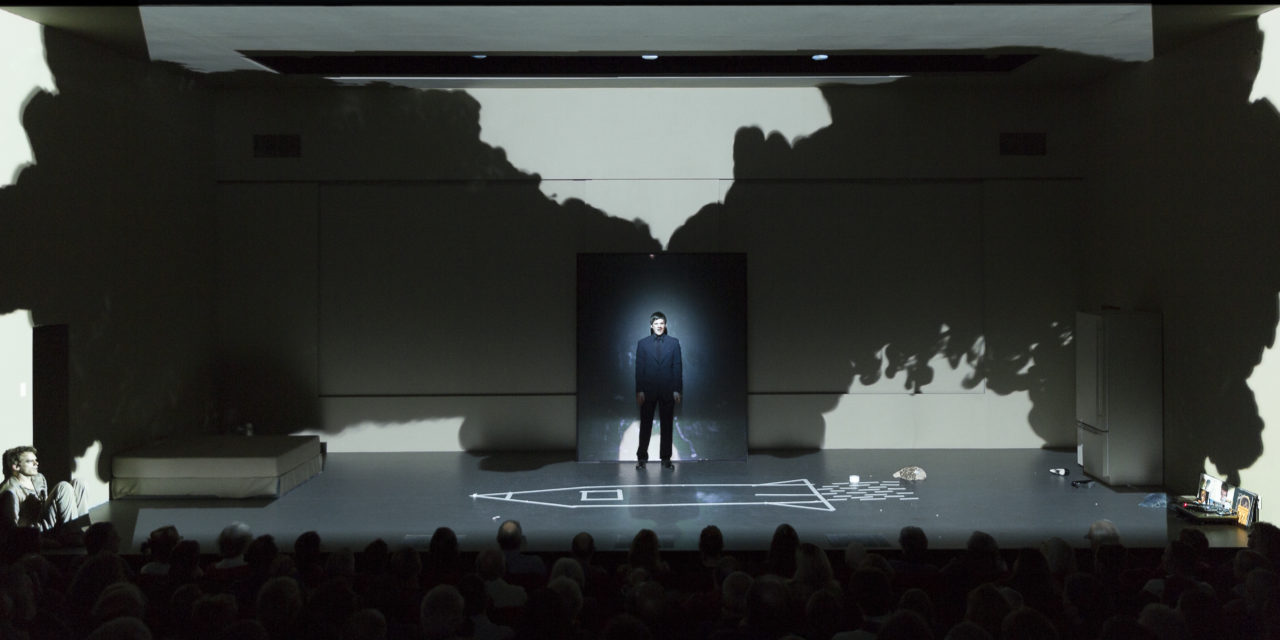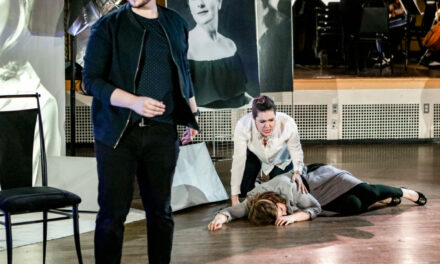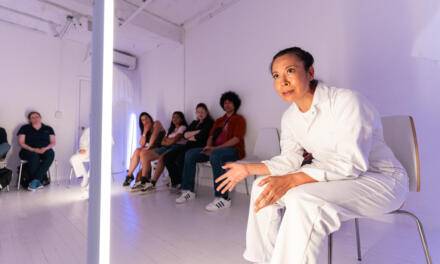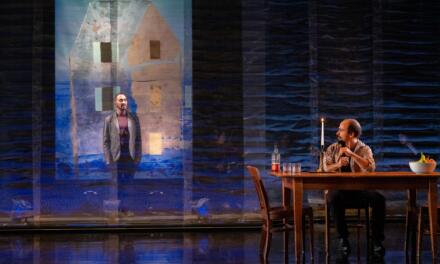In early September, around 20 participants, including I, have ended a magical month as theatre practitioners. The world-renowned theatre scenographer Jan Versweyveld, whose work is always related to productions directed by the acclaimed director Ivo van Hove, came to Hong Kong to run a four-day workshop on his works.
Versweyveld was in the city for only four days, but the whole journey started back in late July when the workshop of What Is Stage: Dynamics Of Seeing, co-presented by West Kowloon Cultural District Authority and Edward Lam Dance Theatre, intensively requires participants to study 11 works in Versweyveld’s experienced résumé.
This workshop also marks the beginning of a three-year-project planned by West Kowloon and Edward Lam on scenography studies.
I was lucky enough to be in both parts of the workshop, and I have to say, this is one of the most rewarding events about theatre I have ever been, and will always remember it.
It is no doubt that the names of Ivo van Hove and Jan Versweyveld hugely pumped up my enthusiasm on participating in the event. I have heard of Ivo van Hove since 2015 when his Young Vic’s production of A View From The Bridge was transferred to the West End in London. Since then, I have had the opportunities to see van Hove’s work, mostly performed in English, and slowly becoming a fan of his works.
What I just said might be also the same experience of a lot of theatre practitioners in Hong Kong who happened to stump upon the name of van Hove, thus as I have heard, the amount of applications of the workshop is huge.
It is wise for West Kowloon to set mini-essay sessions for the applications as the workshop, after all, is for potential artists and, though a lot of people might overlook, audiences to grow through the process. Questions like, “What is scenography?” or “What is the best scenography you have come across so far? Please describe and explain why” tell us that the potential participants should be those who understand the language of design and also at least be thrilled with good scenography. Nonetheless, the workshop is for long-term growth for the industry.
It is also wise to have these answer collected because they are actually for part of the workshop.
Within two weeks, participants needed to watch the 11 productions of van Hove, designed by Versweyveld. However, on the first day of the workshop, we did not see a single show. For the whole three hours, Edward Lam, Hong Kong theatre director, as well as the convener of the workshop, asked each of the participants to come out and introduce themselves.

Screening and Discussion: 11 productions from Jan Versweyveld. Photo Courtesy: West Kowloon Cultural District Authority
Lam asked questions to the “interviewee,” and then showed the answer of each participant to the question “What is scenography?” in the application form on a big screen, which generated more questions.
Each participant also needed to pick a question randomly in a box to answer, which were quite personal. At the end, the “best scenography” each participant selected is shown.
Each participant needed to go through those process, and according to Lam, there was a reason for that. He has a conviction that for a workshop, participants should know each other more than just being there. It is a two-week screening and discussion, and Lam believes that knowing each other should benefit from that.
In other words, “to make friends.”
When I heard about this from Lam, I knew that the workshop would be in good hands. During the first three hours, Lam manifested his skills as a lecturer who does not only lecture but lectures through conversations.
During the following two weeks, Lam prepared a lot of materials apart from the showing the recordings of Versweyveld’s works, giving us references on what he thought Versweyveld’s and van Hove’s inspirations are from. Before Antonioni Project, Lam showed us all the film clips from the Antonioni films in order, which mirrored to the sequence in the production. For Cries And Whispers, we had watched the whole Ingmar Bergman film before we watched the show.
Personally, the references are great, but maybe there was so much information to channel in a very limited time that it sacrificed some of the discussion time. Also, to me, it really does not matter if one has watched the film before seeing a show. We should judge by the show itself, even though to have the opportunity to compare is an additional treat.

Workshop Convenor Edward Lam. Photo Courtesy: West Kowloon Cultural District Authority
However, I must applaud Lam on presenting the 11 shows with the base of a theme that has somehow inspired us to see a space. I remember when Lam showed us the Chinese opera clips, what he wanted to tackle was the use of a stage, and how the use of open space could generate concentration and imagination.
This goes back to Versweyveld’s design on what he said during his workshop later, that he wanted to create a “new reality” that was transcended from the “reality.” What Lam has offered us is a new perspective on seeing emotions on stage instead of just being informed of a story, and I think it merges into Mr. Versweyveld’s design.
The 11 shows, which I have to say, are all with gravitas. Some of them are long (four to six hours) like The Fountainhead, Roman Tragedies, and Kings Of War but they are not boring. Every night when we came out from one of those long screenings, we were just inspired so much that I just kept writing my afterthoughts on the productions on social media, trying to taste more of what we had seen.
Others like Antonioni Project, Cries And Whispers, and Scenes From A Marriage makes me reflect on more about theatre and life.
Along the way, I had a feeling that Versweyveld’s vision of a performing space is not done by auteur signatures but by what he sees and thinks when he reads the text. The stage can be as bare as that in La Voix Humaine or A View From The Bridge, but it can also be as detailed and full of delicate props as those in Kings Of War.
In return, I feel that I actually can have a glimpse of who he is through his work, a person who is just so full of life. His use of water (A View From The Bridge), plants (Kings Of War), and wood (The Fountainhead) gives me a feeling that theatre is more than characters and stories, and offers an honest dialogue between artists and audience through the materials.
I started to feel close to Versweyveld as a pen pal through his work, developing a lot of questions about his thinking process, and most importantly, his collaboration with actors.
It is not a secret that the actors in the shows all gain strength from the designed space, which creates a spell to augment the presence of the actors’ works. The choices of materials highlight not only Versweyveld’s point of view to the text, but also, to me, a playground for actors to explore their possibilities.
I can see Versweyveld’s bold statements and his support to the actors on stage.
With these questions, which are also developed by Lam’s encouragement from the beginning of the two-week screening (he kept asking us what we would like to ask Versweyveld), I highly anticipated the opportunity to meet Versweyveld, because it is a good opportunity to really examine the process of a world-class theatre practitioner.
However, of course, there is always a saying, “Don’t meet your heroes.” After the two-week screening, and when the time to meet Versweyveld was near, I started to have the anxiety of meeting him.
Not to mention Lam split us into groups, and for each group leading a nearly one-hour session with Versweyveld during the four-day workshop. This is where the panic kicked in. How open would he be to answer our questions? How to evaluate our questions’ depth? Would our questions be relevant to the work of scenography?
It turns out that my anxiety is no more than a false alarm. Before even our workshop started, Versweyveld actively greeted everyone, and I could see his generosity right at the moment when we locked eyes. Suddenly, I am not that anxious.
Versweyveld exuded such friendly warmth during that we as participants just could not resist but listen to his stories about each production attentively. Versweyveld shows his personality that speaks honesty, and because of that, at least I kind of loosen my guard on the discussions.
And there, the idea of “to make friends” appeared in my mind when I was listening to Versweyveld’s explanations of the origins of his works. He spoke openly about his creative process, as well as his thoughts on the actors he had worked with. He made jokes, and there was laughter all around during the sessions.
Versweyveld never tried to build a wall between us as “students.” During the session for A View From The Bridge, which was on the first day of the workshop, he exuded his genuine affections. He spoke with lucid passion.
When he talked about it, he could not hide his sensitive feeling towards his creation. “I really think we have done something really special.” I can see why A View From The Bridge is so special to Versweyveld because from what I saw, the production speaks a huge part of Verweyveld’s world of the piece.
We always think that the world created on stage should be the director’s, but the collaboration between Versweyveld and van Hove proves that the vision of a production can be developed starting by the director, and ending it by the scenographer.
Within the four days, we as participants felt that we just did not have enough time to talk to Versweyveld for more information about the shows. Each session is around an hour, and Versweyveld was just immensely generous to share his references and even the presentations he showed to his actors in their first rehearsal of some productions. To see these unfolded is like unwrapping presents. We receive 11 presents, and each is dear and personal to us artists.

Artist Workshop: Vesweyveld (far left) and I (far right). Photo Courtesy: West Kowloon Cultural District Authority
Not only that, during the workshop, Versweyveld was constantly trying to have a conversation with everyone who asked questions. Some questions were actually sharp by questioning his design, but he kept trying to defend his design without talking down to the inquirer. Instead, he put himself in the middle of space, surrounded by participants, so that he was free to get closer to everyone.
And there lies the question of ritual, which is the heart of most of Versweyveld’s design. Lam did ask the participants what they thought about theatre as a ritual during the session for Les Damnés, and I suddenly realized that nearly all of Versweyveld’s design serves the purpose of ritual. He explained that Les Damnés was the ritual to represent the process from life to death through the story of the fall of a wealthy family under Nazi Germany.
It was this that I started to think back about Versweyveld’s design in the 11 shows, and apart from Les Damnés, I can also sense the ritual purposes in Kings Of War, The Fountainhead, Roman Tragedies, and Cries And Whispers, where ordinary actions by characters in all of these productions give immense emotions about the world we are given.
Les Damnés shows us a national funeral (with the audience shown live on a big screen on stage) again and again whenever a character is killed in the story; Roman Tragedies’s design suggests a public forum, and to give the audience an opportunity to freely roaming around the theatre already shows the ritual of citizens under democracy.

Artist Workshop: Jan explained his design on Roman Tragedies. Photo Courtesy: West Kowloon Cultural District Authority
Kings Of War shows us an imagined domestic environment of three kings of England; same as The Fountainhead where stagehands are dressed as architects in the environment of an architectural firm; and Cries And Whispers is the ultimate example of how theatre as ritual can give an aftertaste of grief, by having characters to remove Agnes’s properties on stage after her death as a scene change, which lasted for nearly 20 minutes.
All these designs confirm of what Versweyveld has stressed in the workshop, that he believes that every trivial detail gives a great impact. It is no doubt that the reason why all these shows are so layered is because of that fact that life is layered, and to give life to a story by showing it on stage must trigger to an audience to think about their own lives.
This is the purpose of the “new reality” that Versweyveld strives to create every time, which is a reflection of the audience themselves by them having a dialogue with what they see.
In a similar sense, this workshop is also a “new reality” created by Versweyveld for us artists to have a dialogue with him, and reflect ourselves when a world-class artist is trying to embrace us.
The last day of the workshop was an open discussion with Versweyveld, and one cannot imagine how in-depth our discussion was. We asked how he managed anger, as well as how to collaborate with other artists. The conversation extended, and Versweyveld, by talking about his other works in dance and opera, managed to tell us that as a designer, communication was key.
Even though Versweyveld has collaborated with van Hove for such a long time, “it never gets easier,” and thus, he needs to use methods to get things done. It also shows that Versweyveld implies that one needs to be open and trustful to one another to work for theatre. “I cannot work in an environment where people are not feeling comfortable.” Even when he is now a renowned artist, Versweyveld never ceases to think in others’ shoes.
It is this last conversation, the participants are enlightened. During the sharing session at the end of the workshop, nearly every participant was very emotional. I cannot believe that they would be that open to talk about themselves and their own problems because of what Versweyveld had shown us. His generosity and humbleness inspired us to recall that we as artists are after all humans.
I will not forget what we have been through in these four days.
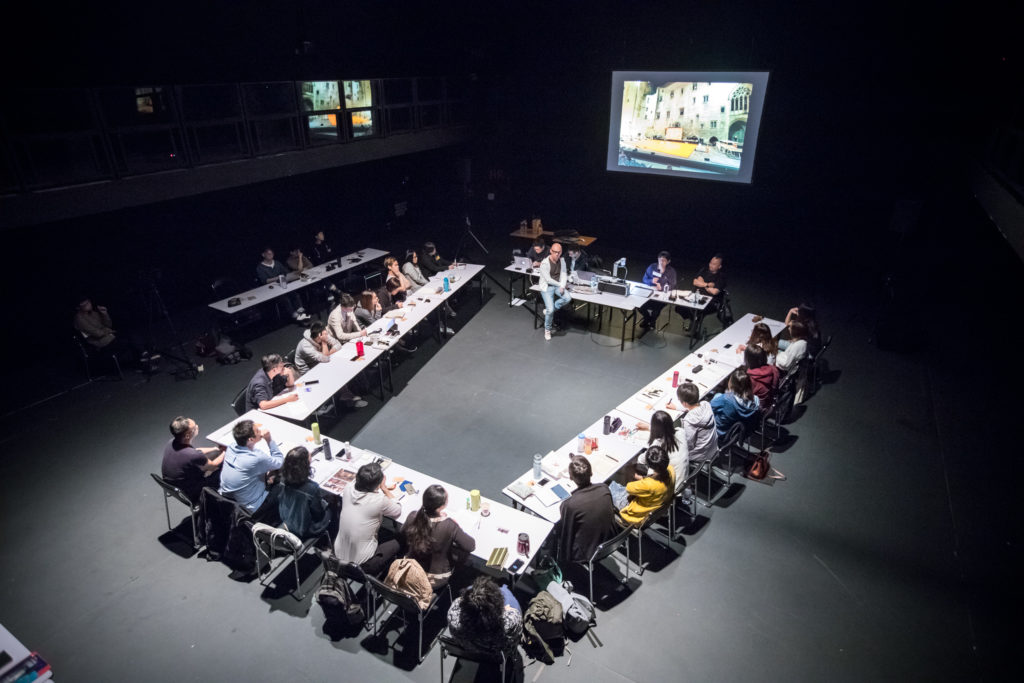
“What Is Stage-Dynamics Of Seeing” – Jan Versweyveld’s Artist Workshop on Scenography. Photo Courtesy: West Kowloon Cultural District Authority
What Is Stage: Dynamics Of Seeing – Jan Versweyveld’s Scenography Workshop
Presented by West Kowloon Cultural District Authority & Edward Lam Dance Theatre
Screening & Discussion: 29th July – 12th August 2017
Artist Workshop: 3rd September – 6th September 2017
Venue: Studio Theatre, Hong Kong Academy of Performing Arts
This article by was originally published in the West Kowloon Cultural District website, edited by Brian Yu. Reposted with permission. Read the original article and its blog page.
This post was written by the author in their personal capacity.The opinions expressed in this article are the author’s own and do not reflect the view of The Theatre Times, their staff or collaborators.
This post was written by Clement Lee.
The views expressed here belong to the author and do not necessarily reflect our views and opinions.

